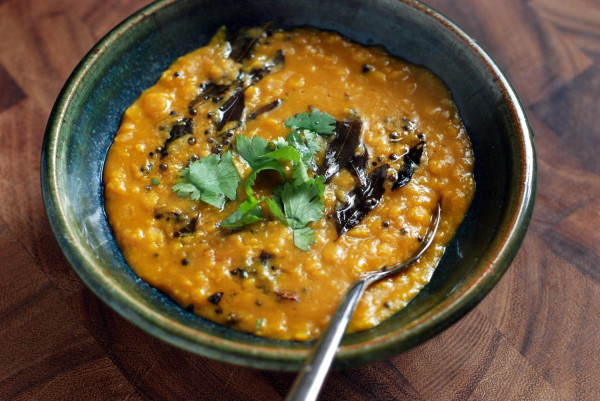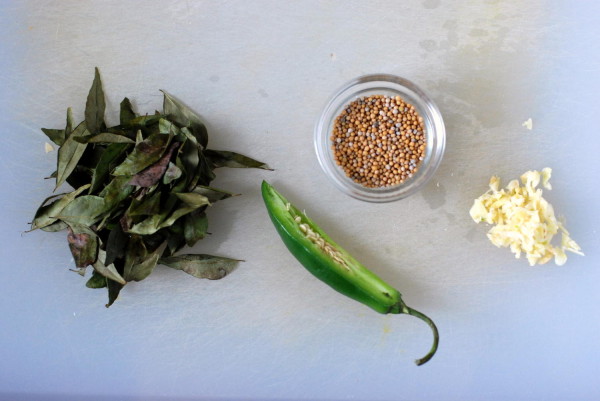Long overdue, this is the latest in my Indian for Dinner series, where I attempt to spend less money on takeout from Masala Art.
I think I speak for all of us when I say that this weather tries all patients. Some days taunt with 70 degrees and sun, but looking outside, it seems to be snowing, yet again, and here we are, facing another day of lost productivity and frigid air.
The silver lining is that this unpredictable and frequently unpleasant weather has given me loads of time to work on my dal-making skills. I love lentils in all forms, but dal reins supreme.
“Dal” is just the Indian term for legumes. The category of dishes called dal includes crunchy snacks, soupy stews, smooth purees, and mixtures with rice not unlike Mujaddara. My favorite is dal makhani, the smoky, tomatoey preparation of dark lentils. But a couple of recent articles about dal have convinced me to expand my horizons beyond the familiar. That’s how I came upon Khatti Dal, a chunky stew of yellow lentils with heaps of curry leaves and plenty of tart tamarind. I’ve been eating it on and off for the past week, retroactively missing it on behalf of all those times I could have made it but didn’t know to.
The key to flavor in this and many other Indian dals is a tarka (or tadka), which is basically a spiced butter. To make the tarka, you heat ghee (or a combination of oil and butter), and add mustard seeds, curry leaves, and garlic. You let everything get super hot and fragrant. When the mustard seeds stop popping and the butter smells like something you need to eat immediately, you pour the whole mess into the pot of cooked, mushed lentils. Then, because reasonably speaking you can’t wait any longer, you ladle a big bowl of the dal into a bowl that fits well in your hands. You wrap yourself in your coziest blanket. And then, you eat up.
And when you’re nice and full and warm, maybe you’ll put in a tiny request with the weatherman to just call it quits on the snow already. What do you think?
More Indian for Dinner:
- Potato and Eggplant Curry
- Chana Dal with Golden Raisins, a real winner
- Mushroom Pea Curry, a weeknight staple around here
- If you feel like something lighter, Gujarati Mango Soup is great
- Finally, Masala Dosas, my crowning achievement
Yellow Lentils with Tamarind (Khatti Dal)
Adapted from Mark Bittman and Julie Sahni, via the New York TimesThis makes enough to feed about 4, but I’d say while you’re at it, make a double batch. It keeps very well in the fridge, and unlike those stray pieces of Saturday’s cake, it’s the sort of thing you’ll want to have lying around.
Also, I understand why Bittman makes the curry leaves optional. Where I live, they’re only available in Indian grocery stores, and the dal will taste great without them. That said, if you have any inclination to schlep, I’d pick some up. They’re part of what makes this dal taste Indian.
1 cup yellow lentils (toor dal)
1 1/2 teaspoons turmeric
1/2 a green (I like serrano) chili, seeded and minced
1 1/4 teaspoons salt
1/4 cup tamarind concentrate or 1 1/2 tablespoons fresh lime juice
2 tablespoons ghee, or neutral oil like safflower
1 teaspoon mustard seeds
1 teaspoon minced garlic
12 curry leaves (optional)
3 tablespoons chopped fresh cilantroCook the dal: Put the dal, tumeric, chili, salt, and 4 cups of water into a pot. Cover and bring to a boil over high heat. When lentils come to a boil, uncover the pot, and cook at a rolling, bubbling boil for 25-35 minutes, until lentils are cooked through.
Add the tamarind concentrate and 1/2 cup additional water, and let bubble for another couple minutes. Turn off the heat. Then use a whisk to stir and break up the lentils; you’re aiming for a smoothish puree that retains a bit of texture. Whisk and mash until the lentils achieve a consistency that you’ll enjoy.
Make the tarka: Heat the ghee or oil in a small saucepan over high heat. When the ghee/oil is hot, add the mustard seeds and cover the pan; let the seeds pop and sizzle. When the popping begins to subside, add the garlic and cook until lightly browned, about 15 seconds. Add the curry leaves, if you’re using them. Cover the pan (to prevent spattering) and cook for about 10 seconds, allowing flavors to meld.
Pour the tarka into the dal, and swirl around to just barely incorporate. Taste, and add more salt if needed. Serve immediately with chopped cilantro.
Dal keeps in the fridge for at least a week. It will thicken when chilled, so reheat with a bit of water to loosen it up.





Comments on this entry are closed.
Rivka:
Thank you for making this dish look less intimidating by giving alternatives to the ingredients. It looks like one trip to a grocery store, instead of 15. Best, Naomi
This looks great, and I have a few questions based on what I can eat/have in my pantry. Mostly because I want to make it this week and can’t run to the store before the weekend!
I only have tamarind in a block… any suggestions on how I would convert that? I was thinking to just reconstitute to make a thick paste equal to 1/4 cup, but I am not sure how thick the concentrate is.
And I don’t have curry leaves, which is really disappointing. I might be able to grab them from the store, but if not, any suggestions? I know you said optional, but with so few ingredients, I don’t want to leave anything out!
Thank you so much!
Lisa, great questions.
Here are some instructions to make tamarind pulp out of block tamarind: http://shesimmers.com/2010/05/how-to-prepare-tamarind-pulp-for-thai.html
As for the curry leaves, it’s tough. There’s really no substitute. Best case, if you have a curry powder that includes ground curry leaves as one of the ingredients, use a teaspoon of that. But really, it’ll be delish regardless.
Happy cooking!
Is that your hardwood floor in the second photo – the one with a pot of uncooked lentils with chili and salt?
Indeed it is! Good eye.
It looks like your dal almost has the consistency of runny mustard (i.e. thicker than most dals I’m used to). How did you get your dal so thick-looking? The whisking?
The other Derek – love it!
This dal is indeed thicker than others I’ve made, and I actually think mine came out thicker than in the original recipe. I really liked it that way. The whisking is a big part of it, but you also need to ensure that the lentils are fully fully cooked, or else they won’t yield to the whisk.
If you have a hard time, you can always blend a small portion of lentils using an immersion or regular blender, and then add them back in. That’ll help thicken the pot.